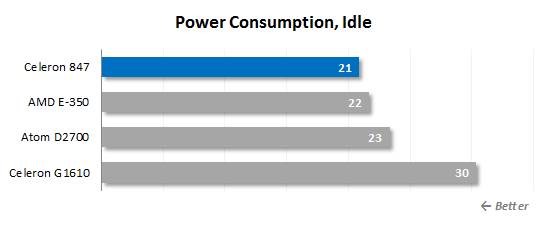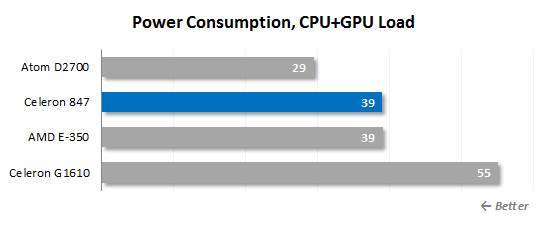Energy consumption
E-series processors from AMD and Intel Atom
were originally designed for energy-efficient computers, so low power
consumption is one of their main functions. A Celeron, especially
based on a 32nm Sandy Bridge core, doesn’t seem fit for energy-efficient
computing, but Celeron 847 has a specified TDP of 17W, which can be compared
with AMD processors with Bobcat architecture. Is it really so? Can a
slowed-down Sandy Bridge really ensure high performance while being comparable
to specialized products optimized for low power consumption?
To answer all these questions, we made a
couple of power consumption tests. We use a new digital Corsair AX760i PSU
which allows measuring the full consumption of each system (exlc. screen) as
measured at the output of the PSU. It is the sum total of the power draw of
each system component. The efficiency of the PSU is not included. CPU running a
32-bit version of the Linx 0.6.4 utility. We use FurMark 1.10.4 utilitiy to
load the graphics core.

Power
consumption, idle
When not working, any modern CPU switch to
a special power-saving states that only consume a few watts. In this case, the
other system's components and the efficiency of the mainboard’s voltage
regulator mask the CPU’s consumption, which is why the Celeron 847-based
platform turns out to be the most economical when idle. However, it is not much
different than the system with Atom D2700 and E-350. LGA1155 Mainboard with
Celeron G1610 need more energy since mini-ITX LGA1155 products feature a
versatile voltage regulator, supporting different CPU and even allows overclocking
them. Its performance is low at low loads, so the Celeron G1610 based
configuration is inferior to the mainboards with simpler and more economical
voltage regulators in this test.

At
full computing load the Celeron 847 based platform needs much power
At full computing load the Celeron 847
based platform needs as much power as the AMD E-350 based one. Atom platform is
expectedly more economical because Atom D2700 has a specified TDP of only 10
watts. Celeron G1610 platform, which is not energy efficient at all, need one
third more power.

Atom
D2700 is the most economical again when it comes to 3D gaming
Atom D2700 is the most economical again
when it comes to 3D gaming, but its speed is far from brilliant. Celeron 847 is
leading among CPUs with more or less acceptable 3D performance. It's almost as
economical as Atom D2700, unlike the AMD E-350.

At
high load combination, platform based on the Brazos and Celeron 847 again can
be compared with each other
At high load combination, platform based on
the Brazos and Celeron 847 again can be compared with each other in terms of
power consumption. Thus, we see the Core microarchitecture becomes really
becomes economical if its voltage is reduced. Although it does not match the
atom, it equals AMD’s Brazos-based solutions in this respect.
Conclusion
Intel’s economical, nettop-oriented
variation of the old Sandy Bridge design looks very
good, although there is nothing new about the Celeron 847 which was previously
available. But seeing the good sales of Brazos-based mini-ITX mainboards and
the lackluster demand for Atom-based mini-ITX solutions, Intel has the right
decisions to cut the price of junior mobile energy-efficient Celeron CPUs with
Sandy Bridge design and re-target them into compact desktop systems, where they
have every opportunity to succeed, according to our tests.
Featuring Intel’s Celeron 847 processor and
NM70 chipset, the mini-ITX mainboards that we have tested is at least as good
as its co-Brazos. Compared to the latter in terms of heat dissipation, power
consumption and price, it delivers much higher performance - not only in
computing tasks but also at HD video playback and even 3D gaming applications.
As a result, the Celeron 847-based configuration can match nettops as well as
other classes of small form-factor PCs, including multi-media centers. Of
course, the Celeron 847 is only half as fast as the slowest Ivy Bridge's
desktop CPU, but its speed is high enough for everyday applications that we use
to run on a home or office computer.
The celeron 847 + NM70 pair does not put an
end to the Atom-based mainboard which has no rival in terms of low power
consumption and can still be used, for example, for small server at home.
However, the Celeron 847, becoming a fully functional Core processor, is a
better choice for compact and economical general-purpose computers.
For MSI C847IS-P33 mainboard that we used
in this review, it is a well-made implementation of the Celeron 847 + NM70
platform. It is very inexpensive, which is its key advantage. Its functionality
is quite limited due to the lack of additional controllers, but nonetheless it
has everything you need and looks attractive in terms of its
functionality/price ratio.
|
Specifications
·
Processor socket: Intel Celeron 847
·
Chip: Intel NM70 Express
·
Memory slots: 2x DDR3 DIMM
·
supportive memory: dual channel DDR3 -
1067/1333
·
PCle 2.0 slot: 1x1 slot
·
Audio codec: Realtek ALC887
·
Gigabit ethernet controller: Realtek RTL8111E
·
Form factor: Mini-ITX
·
Internal ports: 4 USB 2.0; 1 Serial Port; 1
SATA 3.0; 1 SATA 6.0
·
External ports: 4 USB 2.0; 1 mạng Gigabit; 3
Analogue audio; 2 PS/2; Video: VGA, DVI-D
|